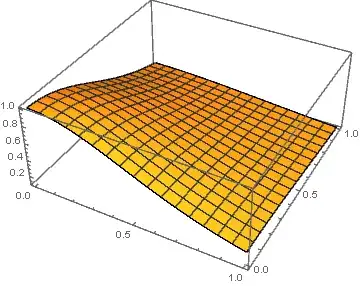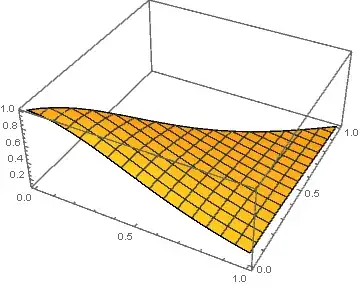$\newcommand{\bbx}[1]{\,\bbox[15px,border:1px groove navy]{\displaystyle{#1}}\,}
\newcommand{\braces}[1]{\left\lbrace\,{#1}\,\right\rbrace}
\newcommand{\bracks}[1]{\left\lbrack\,{#1}\,\right\rbrack}
\newcommand{\dd}{\mathrm{d}}
\newcommand{\ds}[1]{\displaystyle{#1}}
\newcommand{\expo}[1]{\,\mathrm{e}^{#1}\,}
\newcommand{\ic}{\mathrm{i}}
\newcommand{\mc}[1]{\mathcal{#1}}
\newcommand{\mrm}[1]{\mathrm{#1}}
\newcommand{\pars}[1]{\left(\,{#1}\,\right)}
\newcommand{\partiald}[3][]{\frac{\partial^{#1} #2}{\partial #3^{#1}}}
\newcommand{\root}[2][]{\,\sqrt[#1]{\,{#2}\,}\,}
\newcommand{\totald}[3][]{\frac{\mathrm{d}^{#1} #2}{\mathrm{d} #3^{#1}}}
\newcommand{\verts}[1]{\left\vert\,{#1}\,\right\vert}$
$\ds{\bbox[5px,#ffd]{\int_{0}^{1}\int_{0}^{1}\int_{0}^{1}
\pars{1 + u^{2} + v^{2} + w^{2}}^{-2}\,\,\dd u\,\dd v\,\dd w}:\
{\Large ?}}$.
With
$\ds{\large\vec{r} \equiv u\,\hat{u} + v\,\hat{v} +w\,\hat{w}}$:
\begin{align}
&\bbox[5px,#ffd]{\int_{0}^{1}\int_{0}^{1}\int_{0}^{1}
\pars{1 + u^{2} + v^{2} + w^{2}}^{-2}\,\,\dd u\,\dd v\,\dd w} =
\iiint_{\large\pars{0,1}^{3}}{\dd^{3}\vec{r} \over
\pars{1 + r^{2}}^{2}}
\\[5mm] = &\
\iiint_{\large\pars{0,1}^{3}}\bracks{%
-\,{1 \over 4\pi}\,\nabla^{2}\Phi\pars{r}}{\dd^{3}\vec{r}}
\\[2mm] &\ \mbox{where}\
\Phi\pars{r} = 4\pi\int_{0}^{\infty}
{1 \over \pars{1 + r\,'^{2}}^{2}}\,{r\, '^{2}\,\dd r\, ' \over \max\braces{r,r'}} = 2\pi\,{\arctan\pars{r} \over r}
\end{align}
It turns out -via
Gauss-Ostrogradsky's Divergence Theorem- that
\begin{align}
&\bbox[5px,#ffd]{\int_{0}^{1}\int_{0}^{1}\int_{0}^{1}
\pars{1 + u^{2} + v^{2} + w^{2}}^{-2}\,\,\dd u\,\dd v\,\dd w}
\\[5mm] = &
-\,{1 \over 4\pi}\iint_{S}
\nabla\Phi\pars{r}\cdot\dd\vec{S}\quad
\pars{\begin{array}{l}
\ds{S}\ \mbox{is the}\ \ds{\pars{0,1}^{3}}\
\mbox{box surface}
\end{array}}
\end{align}
By symmetry considerations:
- The contribution, to the surface integration, from the sides that intersects the origin of coordinates $\underline{vanish\ out}$.
- Each of the $\underline{\color{red}{three}}$ remaining sides yields the same contribution to the surface integration.
Then,
\begin{align}
&\bbox[5px,#ffd]{\int_{0}^{1}\int_{0}^{1}\int_{0}^{1}
\pars{1 + u^{2} + v^{2} + w^{2}}^{-2}\,\,\dd u\,\dd v\,\dd w}
\\[5mm] = &\
\color{red}{3}\braces{-\,{1 \over 4\pi}\iint_{\pars{0,1}^{2}}
\bracks{\partiald{\Phi\pars{r}}{z}}_{\ z\ = 1}\dd x\,\dd y}
\\[5mm] = &\
-\,{3 \over 2}\iint_{\pars{0,1}^{2}}
\braces{\partiald{}{r}\bracks{{\arctan\pars{r} \over r}}
\, {1 \over r}}_{\ z\ =\ 1}\dd x\,\dd y
\\[5mm] = &\
3\int_{1}^{\infty}\bracks{\int_{0}^{1}\int_{0}^{1}
{\dd x\,\dd y \over \pars{x^{2} + y^{2} + t^{2} + 1}^{2}}}\dd t
\\[5mm] = &\
3\int_{1}^{\infty}{\mrm{arccot}\pars{\root{2 + t^{2}}} \over
\pars{1 + t^{2}}\root{2 + t^{2}}}\,\dd t
\\[5mm] = &\
{3\pi \over 2}\
\underbrace{\int_{1}^{\infty}
{\dd t \over \pars{1 + t^{2}}\root{2 + t^{2}}}}
_{\ds{\pi \over 12}}\ -\
3\
\underbrace{\int_{1}^{\infty}{\arctan\pars{\root{2 + t^{2}}} \over
\pars{1 + t^{2}}\root{2 + t^{2}}}\,\dd t}
_{\ds{\pi^{2} \over 32}}
\\[5mm] = &\
\bbx{\large{\pi^{2} \over 32}} \approx 0.3084 \\ &
\end{align}

